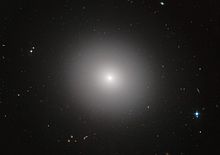User:Ahanania/sandbox
General characteristics
[edit]
Elliptical galaxies are characterized by several properties that make them distinct from other classes of galaxy. They are spherical or ovoid masses of stars, starved of star-making gases. The smallest known elliptical galaxy is about one-tenth the size of the Milky Way[citation needed]. The motion of stars in elliptical galaxies is predominantly radial[citation needed], unlike the disks of spiral galaxies, which are dominated by rotation. Furthermore, there is very little interstellar matter (neither gas nor dust), which results in low rates of star formation, few open star clusters, and few young stars; rather elliptical galaxies are dominated by old stellar populations, giving them red colors. Large elliptical galaxies typically have an extensive system of globular clusters.[1]
The dynamical properties of elliptical galaxies and the bulges of disk galaxies are similar, [2] suggesting that they may be formed by the same physical processes, although this remains controversial. The luminosity profiles of both elliptical galaxies and bulges are well fit by Sersic's law.
Every massive elliptical galaxy contains a supermassive black hole at its center.[3][citation needed] Observations of 46 elliptical galaxies, 20 classical bulges, and 22 pseudobulges show that each contain a black hole at the center.[4] The mass of the black hole is tightly correlated with the mass of the galaxy, via the M–sigma relation which relates the velocity dispersion of the surrounding stars to the mass of the black hole at the center.
Elliptical galaxies are preferentially found in galaxy clusters and in compact groups of galaxies.
Evolution
[edit]
It is widely accepted that the evolution of elliptical galaxies is primarily composed of the merging of smaller galaxies. Many galaxies in the universe are gravitationally bound to other galaxies, which means that they will never escape the pull of the other galaxy. If the galaxies are of similar size, the resultant galaxy will appear similar to neither of the two galaxies merging,[6] but will instead be an elliptical galaxy.[7]
Such major galactic mergers are thought to have been common at early times, but may occur less frequently today. Minor galactic mergers involve two galaxies of very different masses, and are not limited to giant ellipticals. For example, our own Milky Way galaxy is merging with a couple of small galaxies right now.[citation needed] The Milky Way galaxy is also, depending upon an unknown tangential component, on a collision course in 4–5 billion years with the Andromeda Galaxy. It has been theorized that an elliptical galaxy will result from a merger of the two spirals.[8] [better source needed]
It is believed that black holes may play an important role in limiting the growth of elliptical galaxies in the early universe by inhibiting star formation.[citation needed]
Habitability
[edit]A study published in The Astrophysical Journal Letters in 2015 suggests that elliptical galaxies could harbor far more habitable planets than equivalent spiral galaxies, for example a giant elliptical galaxy twice as massive as the Milky Way being able to hold ten thousand times more Earth-like planets than the latter[9]
 | This is a user sandbox of Ahanania. You can use it for testing or practicing edits. This is not the sandbox where you should draft your assigned article for a dashboard.wikiedu.org course. To find the right sandbox for your assignment, visit your Dashboard course page and follow the Sandbox Draft link for your assigned article in the My Articles section. |
NOTES
[edit]I am thinking about removing the Habitability section from the page. Will add a few wikilinks to the page.
- ^ Binney, J.; Merrifield, M. (1998). Galactic Astronomy. Princeton: Princeton University Press. ISBN 978-0-691-02565-0. OCLC 39108765.
- ^ Merritt, D. (February 1999). "Elliptical galaxy dynamics". The Astronomical Journal. 111 (756): 129–168. arXiv:astro-ph/9810371. Bibcode:1999PASP..111..129M. doi:10.1086/316307. S2CID 14447270.
- ^ (Ho 2010, p. 583)
- ^ Kormendy, John; Ho, Luis C. (March 2, 2017). "Coevolution (Or Not) of Supermassive Black Holes and Host Galaxies". Annual Review of Astronomy and Astrophysics. 51: 511–653. arXiv:1304.7762. doi:10.1146/annurev-astro-082708-101811. S2CID 118172025. Retrieved March 2, 2017.
- ^ "Elliptical galaxy IC 2006". www.spacetelescope.org. ESA/Hubble. Retrieved 21 April 2015.
- ^ Barnes, Joshua E. (1989-03-09). "Evolution of compact groups and the formation of elliptical galaxies". Nature. 338 (6211): 123–126. Bibcode:1989Natur.338..123B. doi:10.1038/338123a0. S2CID 4249960.
- ^ (Ho 2010, pp. 12, 22, 23)
- ^ Nemiroff, R.; Bonnell, J., eds. (4 June 2012). "Milky Way Galaxy Doomed: Collision with Andromeda Pending". Astronomy Picture of the Day. NASA.
- ^ Dayal, Pratika; Cockell, Charles; Rice, Ken; Mazumdar, Anupam (1 September 2015). "The Quest for Cradles of Life: Using the Fundamental Metallicity Relation to Hunt for the Most Habitable Type of Galaxy". The Astrophysical Journal Letters. 810 (1): L2. arXiv:1507.04346. Bibcode:2015ApJ...810L...2D. doi:10.1088/2041-8205/810/1/L2. ISSN 0004-637X. S2CID 54048749.
